Musk oxen and bison, both iconic representatives of the Arctic and North American plains, respectively, share several similarities but differ significantly.
Bison, primarily found in the North American plains, are large, muscular and hump-backed, feeding mainly on grass. Musk oxen, on the other hand, are smaller, rounder animals native to Arctic conditions, surviving on a diet of Arctic plants and mosses.
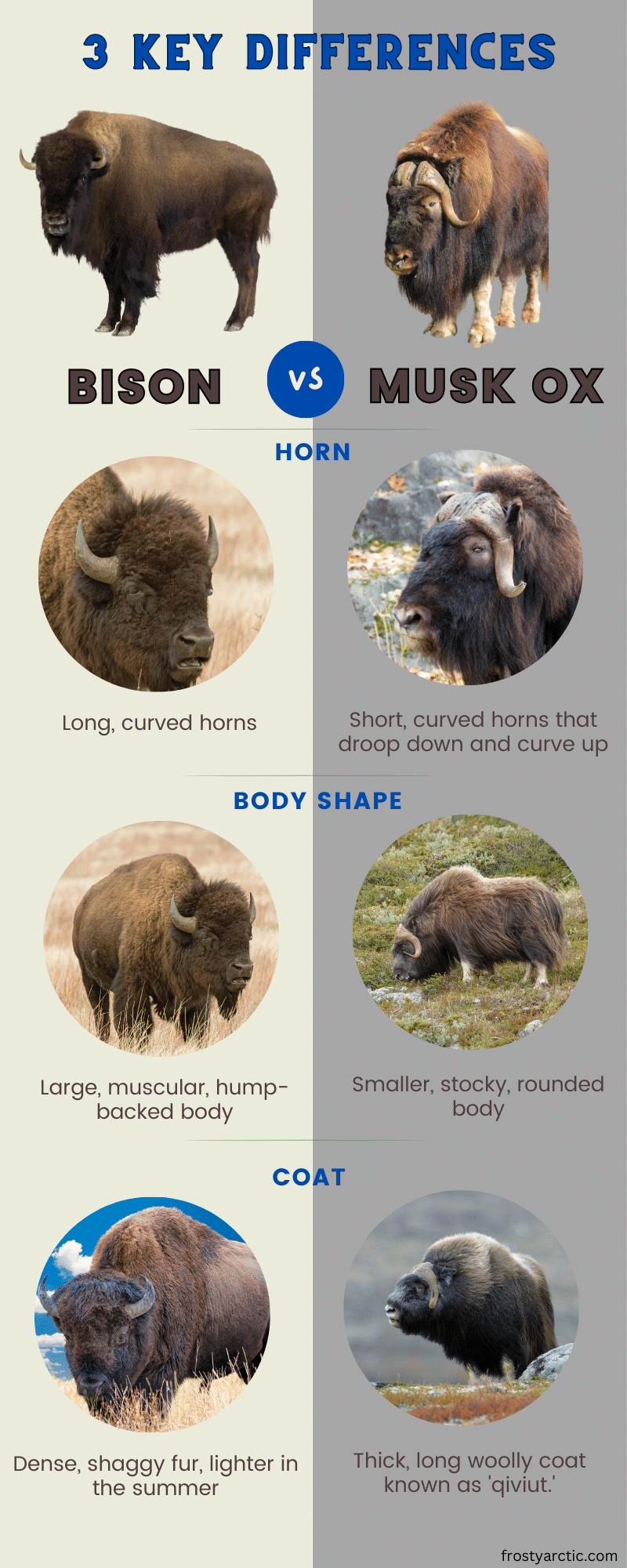
But there’s so much more to these creatures than their diet and physical build! Bison and musk oxen are both symbols of wild places, but their behaviors, social structures, and even mating rituals are unique.
So, buckle up and prepare for an exciting journey across the cold Arctic and the wide North American grasslands as we delve deep into the captivating world of the musk ox and the bison. We assure you that the differences are as breathtaking as the landscapes they call home.
Bison vs Musk Ox – A Quick Comparison Table
Let’s take a quick look at the differences between these two creatures.
| Feature | Bison | Musk Oxen |
| Scientific name | Bison bison | Ovibos moschatus |
| Body Shape | Large, muscular, hump-backed body | Smaller, stocky, rounded body |
| Horns | Long, curved horns | Short, curved horns that extend out from the sides of the head |
| Coat | Dense, shaggy fur, lighter in the summer | Thick, long woolly coat |
| Size | Up to 11.5 feet long, weighing around 900 kg | Up to 8.5 feet long, weighing up to 450 kg |
| Diet | Primarily grasses | Arctic plants and mosses |
| Habitat | Grasslands and prairies in North America | Arctic tundra and mountain regions |
| Social Behavior | Herds consist of females and calves. Males either form small groups or roam solo. | Herds of up to 75 animals, with up to 15 females and calves, led by a mature bull. |
| Lifespan | Up to 20 years in the wild | Almost 20 years in the wild |
| Gestation period | About 9.5 months, a single calf born | About 8.5 months, a single calf born |
| Conservation status | Near Threatened | Least concern |
| Common names | Buffalo | Musk Ox, Musk Oxen |
Bison vs Musk Ox – What Are the Key Differences?

Bison and musk oxen are both imposing mammals from the Bovidae family. While they share similar robust builds and have a plant-based diet, there are significant differences that set them apart.
Also Read: Yak vs Musk Ox: Key Differences Explained
Let’s journey through the vast expanse of the Arctic tundra and North American plains to discover who’s who in the world of these terrestrial giants.
1. Taxonomy and Classification
Bison and musk oxen belong to two different subfamilies within the order Artiodactyla, more commonly known as the even-toed ungulates.
Bison
Bison belong to the Bovidae family, sub-family Bovinae, and the Bison genus. According to Integrated Taxonomic Information System (ITIS), the scientific name for American bison is Bison bison, whereas the European bison is Bison bonasus.
These mighty beasts first appeared around 2.6 million years ago and have been symbolic of the great North American plains.
Musk Ox
Musk oxen, on the other hand, are also part of the Bovidae family but belong to the sub-family Antilopinae and Ovibos genus. Musk oxen are scientifically known as Ovibos moschatus.
According to National Park Service, Musk oxen, adapted to the extreme cold, first appeared around 129,000 years ago.
| Taxonomic Rank | Bison | Musk Ox |
| Kingdom | Animalia | Animalia |
| Phylum | Chordata | Chordata |
| Class | Mammalia | Mammalia |
| Order | Artiodactyla | Artiodactyla |
| Family | Bovidae | Bovidae |
| Sub-family | Bovinae | Antilopinae |
| Genus | Bison | Ovibos |
| Species | Bison bison (American Bison), Bison bonasus (European Bison) | Ovibos moschatus |
2. Habitat and Distribution
Bison and musk oxen occupy starkly different habitats across the globe due to their unique adaptations and physiological needs.
Bison
According to the National Park Service, Bison are native to North America and Eastern Europe.
The American bison historically roamed much of North America. But today, they are primarily found in reserves, parks, and ranches across the United States and Canada.
European bison, also known as wisent, inhabit forests and grasslands in Eastern Europe, particularly in Poland, Belarus, and Russia.
Musk Ox
As detailed in the Handbook of Natural Fibres (Second Edition), Musk Ox is native to the Arctic regions of North America and Greenland. They can survive in icy environments, where temperatures drop as low as -40 degrees Celsius.
Although musk oxen were wiped out in Alaska in the late 19th century, reintroduction programs have been successful, and they can now be found in parts of northern Alaska and Canada, as well as Greenland and some parts of Scandinavia.
| Bison | Musk Ox | |
| Habitat | Grasslands, prairies, and forests | Arctic tundra |
| Distribution | United States, Canada, and Eastern Europe | Greenland, Canada, Alaska, and Scandinavia |
3. Physical Appearance
Bison and musk oxen, being different species, have distinct physical characteristics tailored to their respective habitats.
Bison
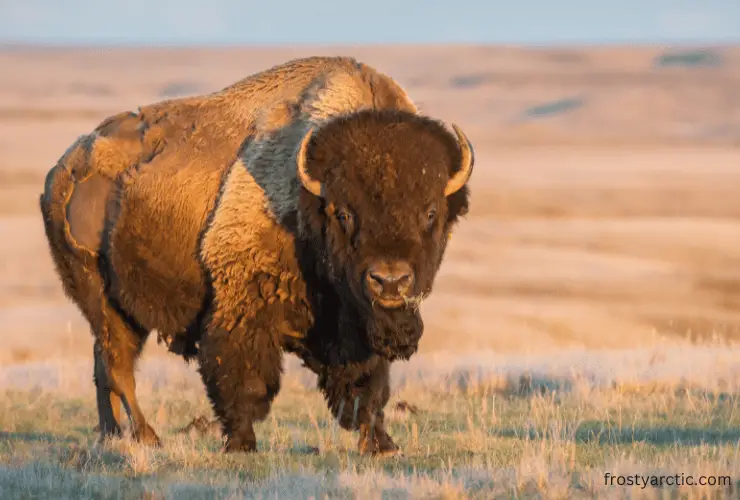
- Size: Adult bison are almost 7 feet tall at the shoulder and can reach lengths of 10 to 12.5 feet. Males weigh approximately 2000 pounds, whereas females are usually smaller, around 1000 pounds.
- Shape: Bison have a large hump over their shoulders and a long, shaggy mane covering their heads, necks, and shoulders. Their hindquarters are significantly smaller.
- Horns: Both male and female bison have large, sharp horns. The horns of a bison can reach lengths of 24 inches (61 centimeters).
- Coat: Their coat is dark brown to black. It is thick and woolly, providing excellent insulation in the winter. In the summer, bison shed their heavy coat to keep cool.
Did you know? Bison are the largest land mammals in North America. ~ Source
Musk Ox
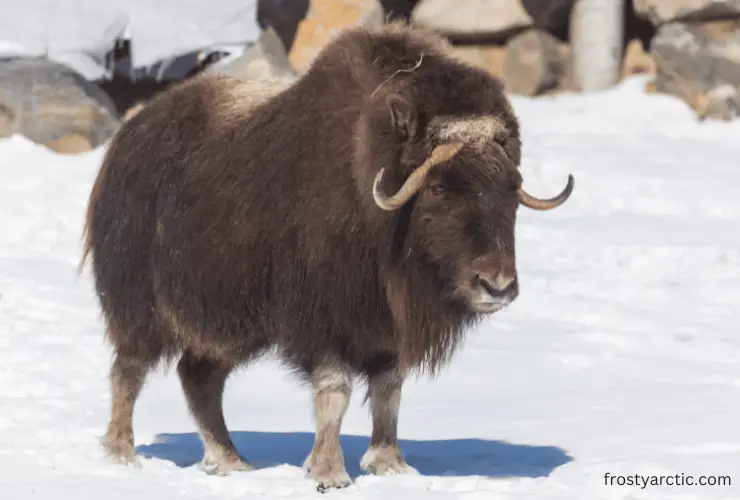
- Size: As per the Alaska Department of Fish and Game, musk oxen are smaller than bison, ranging 4 to 5 feet at the shoulder with a weight of around 800 pounds. They can reach lengths of around 8 feet (2.5 meters).
- Shape: Musk oxen have a compact, robust build with a large, rounded body and short legs. They have a slight shoulder hump and a very short tail. Their body is designed to retain heat, an essential adaptation for survival in the harsh Arctic climate.
- Horns: Musk ox has large, curved horns that extend down the sides of its head. The horns of a musk ox can reach lengths of up to 24 inches (61 centimeters), similar to bison. Their hooves are cloven, all 4 of which are similar in size.
- Coat: As detailed in Advances in Parasitology, Musk oxen have two layers of fur: a long, shaggy outer coat called guard hairs and a dense, soft undercoat called qiviut. Qiviut is eight times warmer compared to sheep’s wool and finer than cashmere.
| Physical Features | Bison | Musk Ox |
| Size | Up to 10-12.5 feet long, 7 feet tall | Up to 8 feet long, 4-5 feet tall |
| Weight | Up to 2000 pounds | Up to 800 pounds |
| Horns | Short, sharp horns up to 24 inches long | Large, curved horns up to 24 inches long |
| Coat | Thick, woolly coat | Long guard hairs and dense, soft qiviut undercoat |
4. Diet and Feeding Habits
Both bison and musk oxen are herbivores, but their diets differ significantly due to the distinct flora available in their habitats.
Bison
As described in a study by Scientific Reports, bison are predominantly grazers, mainly feeding on
- Grasses
- Herbs
- Twigs
- Leaves.
Their large, muscular tongues allow them to grasp and pull grasses easily.
During the winter, they use their massive heads like a plow to clear snow and reach the vegetation underneath.
Musk Ox
Musk oxen, according to a study published in Ecography, have a varied diet that includes
- Grasses
- Forbs
- Lichens
- Sedges
- Woody plants such as dwarf willows, dwarf alders, and dwarf birch.
- Mosses
In winter, they use their sharp hooves to break through the icy snow to reach the lichens and mosses beneath. This diverse diet allows them to survive in the nutrient-poor Arctic environment.
| Bison | Musk Ox | |
| Diet | Grasses, herbs, twigs, leaves | Grasses, forbs, lichens, sedges, woody plants, mosses |
| Feeding Habits | Grasp and pull grasses using their large, muscular tongues. Use their heads to plow through snow in winter | Use sharp hooves to break through icy snow to reach food in winter |
5. Social Behavior
Both bison and musk oxen are social animals and live in herds, but their social structures and behaviors are distinct.
Bison
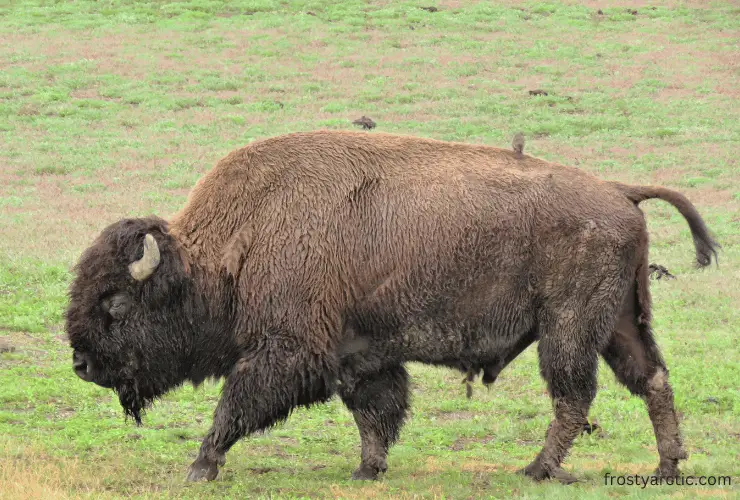
Bison typically move in herds. The herd size can vary greatly, depending on their location, threats, and food availability.
Herds usually include only female bison (cows) and calves outside the breeding season. The male bison (bulls) move in small groups or go alone.
Bulls only briefly join the herds with females and calves during the mating season. They might stay for a few days or a week to win over a female and then protect her from other bulls. This behavior helps ensure that the bull is the calf’s father, allowing him to pass on his genes to the next generation.
Musk Ox
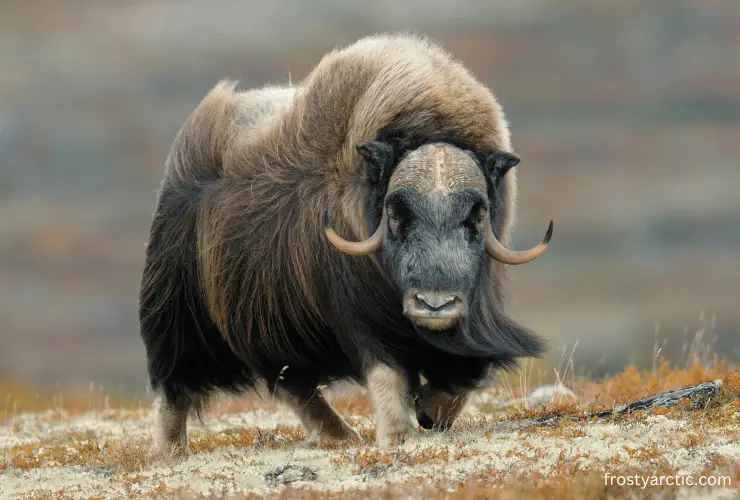
According to the Alaska Department of Fish and Game, Muskox herds can contain up to 75 animals. Groups typically consist of 5 to 15 females and young males, overseen by a single dominant mature bull.
Mature bulls often travel over extensive distances alone, seeking a group of females, and then become part of mixed-sex herds in the winter. Some bulls form groups consisting only of males during the spring and summer.
| Bison | Musk Ox | |
| Social Structure | Herds consist of females and calves outside the mating season. Males either form small groups or roam solo. | Herds of up to 75 animals, with 5 to 15 females and young males, led by a mature bull. |
| Mating Behavior | Males briefly join the female and calf herds during mating season, staying for a few days or a week to court a female and guard her against other males. | Mature males travel long distances alone, seeking a group of females. They join mixed-sex herds in winter. |
6. Reproduction And Lifecycle
Bison and musk oxen share similar reproductive patterns as large mammals, but the specifics of their reproductive cycles and lifespan are unique to each species.
Bison
According to the Current Therapy in Large Animal Theriogenology (Second Edition), the breeding season for bison, also known as the rut, takes place from late June to September.
Females (cows) start breeding at the age of 2 and have a gestation period of approximately 285 days, typically giving birth to a single calf in April or May.
The life expectancy of bison in the wild is approximately 15-20 years, although they have been known to live up to 40 years in captivity. ~ Source
Musk Ox
As detailed in the University of Alaska publication, musk oxen have a similar reproductive cycle.
The breeding season takes place from early July to mid-October.
Females also begin breeding at about two years of age and have a gestation period of approximately 8.5 months, typically giving birth to a single calf in early April to late June.
The life expectancy of a musk ox in the wild is around 12-20 years.
| Reproduction | Bison | Musk Ox |
| Breeding Season | Late June to September | July to mid-October |
| Age at Maturity | 2-3 years | 2 years |
| Gestation Period | Approximately 285 days | Approximately 8.5 months |
| Offspring | Single calf | Single calf |
| Lifespan | Almost 15 to 20 years in the wild | Almost 12-20 years in the wild |
7. Natural Predators
Both bison and musk oxen are large mammals known for their impressive bulk and resilient nature. Their significant size and defensive capabilities offer protection from many potential predators.
Bison
Bison have few natural predators due to their sheer size and strength. The main predators of bison, particularly the calves or weak adults, are wolves and bears (grizzly and black bears).
Occasionally, mountain lions and coyotes may also prey on them, but they usually target young or weak individuals. ~ Source
Musk Ox
Musk oxen have fewer natural predators due to their inhospitable environment. The primary predator of the musk ox is the wolf, with wolverines, brown bears, grizzly bears, and polar bears also known to prey on young or weak individuals occasionally.
| Species | Natural Predators |
| Bison | Wolves, Grizzly Bears, Black Bears, Mountain Lions, Coyotes |
| Musk Ox | Wolves, Brown Bears, Grizzly Bears, Polar Bears, Wolverines |
8. Defense Mechanisms
Bison and musk oxen are built for survival in harsh conditions, and part of their survival strategy includes effective defense mechanisms against predators.
Bison
As detailed in the journal Behaviour, Bison are known for their impressive strength and agility, despite their large size. A primary defense mechanism for bison is their stampede, which can be both a defensive and offensive strategy.
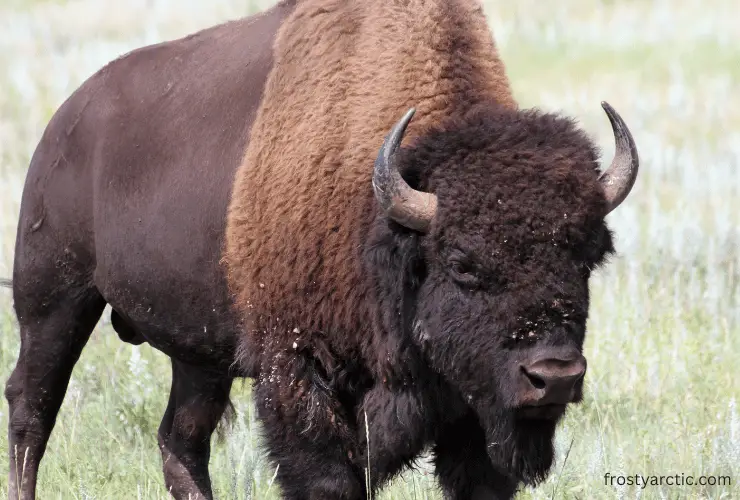
If a predator comes close, the female bison will make a line or circle the calves, and the males form an outer circle around the females, looking straight at the threat. This way, the calves, and weaker bison are safer from natural predators, especially wolves.
Furthermore, their thick skull and strong horns serve as powerful tools for defense. It would take a whole group of wolves to take down a strong, healthy female bison. Bison are known to charge and gore predators, and their ability to run at high speeds helps them escape dangerous situations.
Did you know? Bison can run at 65 kilometers per hour. They can jump up to 1.8 meters high.
Musk Ox

According to the Encyclopedia of Animal Behavior (Second Edition), Musk oxen are famous for their unique group defense mechanism. When encountered by predators, musk oxen form a defensive circle or line, with the mature ones facing outward and the calves shielded in the middle. This arrangement makes it hard for predators to attack the vulnerable calves.
If faced with a single predator, they form a line, all facing the threat. This behavior is particularly effective against their primary predators, such as wolves and bears. From time to time, a bull might rush at the predator.
They snort loudly, blow, and pound their hooves to scare off the predators. Their thick fur and tough, sharp horns also provide individual defense against attackers.
However, the sight of predators can also trigger a stampede, causing the herd to flee. Such stampedes can leave individual muskoxen, particularly calves, exposed and vulnerable.
| Species | Defense Mechanisms |
| Bison | Stampedes, Multilayer circle of protection, Charge at Predators, Goring with Horns, Speed |
| Musk Ox | Form Defensive Circles or Lines, Goring with Horns, Thick Fur |
9. Interactions With Humans
Both bison and musk oxen have extensively interacted with humans throughout history, from prehistoric times to the present.
Bison
Historically, bison were an essential resource for Native Americans, providing food, hides for shelter and clothing, and bones for tools. However, with European settlement, bison were hunted close to extinction in the 1900s.
Efforts in recent years have been sought to conserve and restore bison populations. Bison is now a key attraction in national parks and reserves in many areas, and there are managed hunts to control their population.
Musk Ox
Musk oxen have had a similar history of interactions with humans. Inuit and other Arctic peoples have hunted musk oxen for thousands of years for food, hide, and qiviut (the musk ox’s soft underwool).
Like bison, musk oxen were nearly hunted to extinction but have been reintroduced in several areas and are now protected. Today, they are often a focal point for Arctic wildlife tourism, and their wool is a prized resource for knitting.
| Species | Interactions with Humans |
| Bison | Hunting (historical and managed hunts), Tourism |
| Musk Ox | Hunting (historical and managed hunts), Wool Harvesting, Tourism |
10. Threats and Conservation Status
Bison and musk oxen, despite their strength and resilience, face significant threats, mainly due to human activities. Conservation measures have been implemented to help protect and preserve these species.
Bison
Historically, the primary threats to bison have been overhunting and habitat loss due to agriculture and urban development. The conservation status of the bison is “Near Threatened,” according to the IUCN Red List.
Currently, efforts are being made to recover their populations, with several national parks and reserves established as protected habitats.
Musk Ox
Musk oxen face similar threats, including overhunting and climate change, which impact the Arctic ecosystem and their food sources.
The musk ox’s conservation status is “Least Concern,” as per the IUCN Red List, although certain subpopulations may be at risk.
Did you know? By the mid-18th century, musk oxen were extinct due to hunting by natives, explorers, and whalers in Alaska. Experts estimated the global population of musk oxen to be around 5000 in the early 1900s, signaling a risk of extinction, as reported in the Encyclopedia of Dairy Sciences (Second Edition).
However, starting in 1917, the Canadian Government implemented protective measures to safeguard the species from hunting and took action to conserve musk oxen. They were reintroduced into several regions where they were previously extinct, and protective laws have been enacted in many places to prohibit or regulate hunting.
| Species | Threats | Conservation Status |
| Bison | Overhunting, Habitat Loss | Near Threatened (IUCN) |
| Musk Ox | Overhunting, Climate Change | Least Concern (IUCN) |
Wrapping Up
So, are Bison and Musk Ox the same? Absolutely not! Even though they might seem similar and share the title of grassland and tundra titans, bison and musk oxen are distinct species.
They are both members of the Bovidae family, but they hail from different genera. Bison, from the genus Bison, are known for their large, muscular bodies and hump-backed shape. On the other hand, Musk Oxen belong to the genus Ovibos, adapted to harsh Arctic conditions with their rounded bodies and long, woolly coats.
Their common traits and differences create a real-life ‘spot-the-difference challenge in the animal kingdom! We hope you’ve enjoyed learning about all these fascinating contrasts between these remarkable creatures of the land!

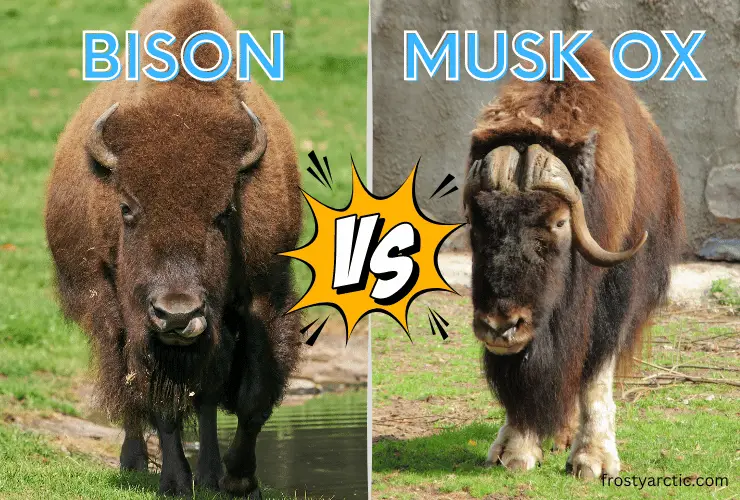

3 thoughts on “Bison vs Musk Ox: Key Differences Explained with Photos”